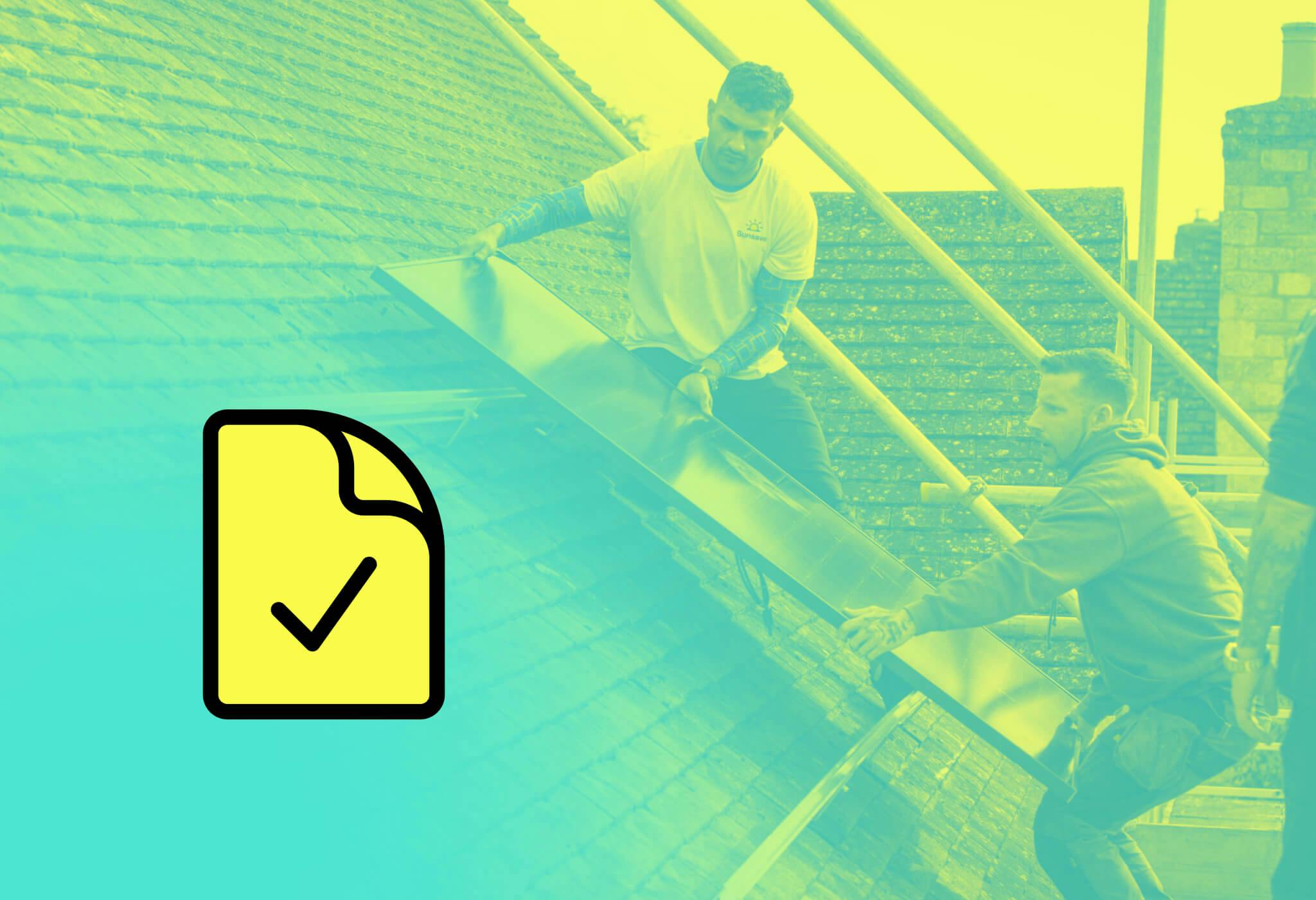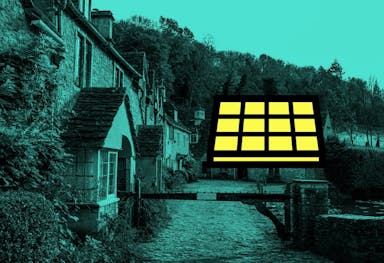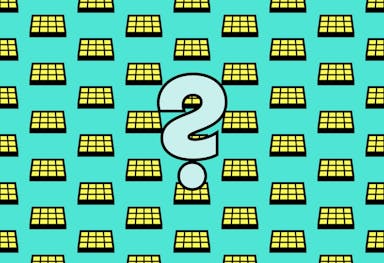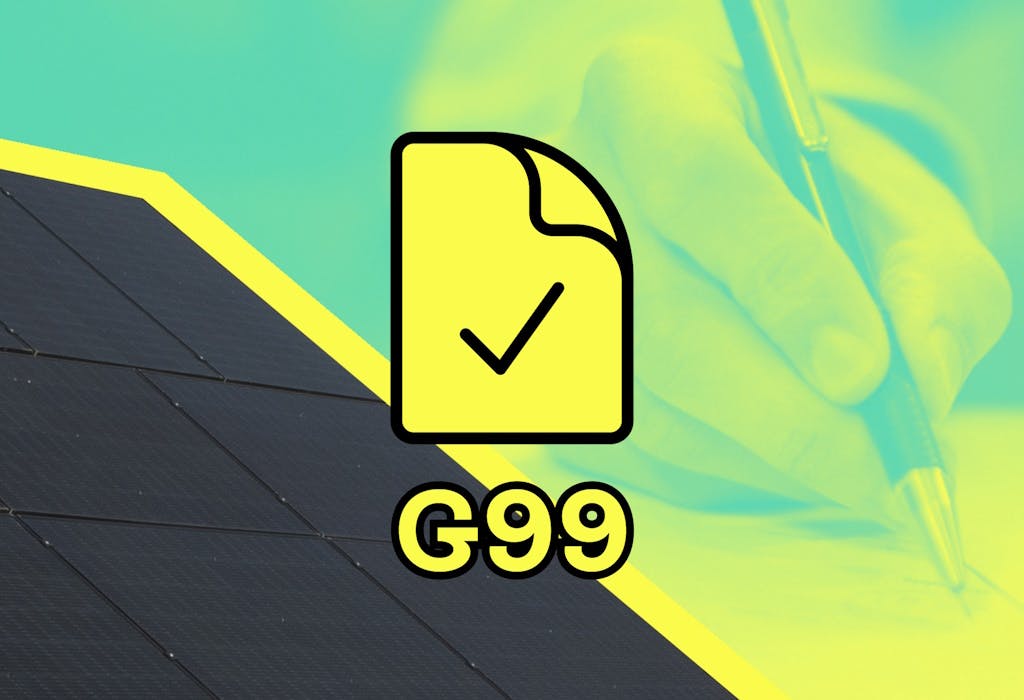- Solar advice hub
- Planning-permission
- Planning permission for solar panels: an expert guide
Planning permission for solar panels: an expert guide
Find out which solar installations need planning permission in the UK.


Why you can trust our content
We know that the solar industry is full of misinformation, but we only use reliable sources, including:
- Our experienced solar experts, installers and system designers
- Our own database of solar & battery system designs
- Authoritative bodies like MCS and the UK government




Calculate savings
What kind of home do you live in?
Calculate savings
What kind of home do you live in?
At a glance
If you’ve decided to get solar panels, the last thing you want is for planning permission to massively delay or scupper your project.
Fortunately, the great majority of homeowners can install solar panels without attaining any additional approval.
In this guide, we’ll explain which properties need planning permission, and the best ways to go about getting it without too much trouble.
If you’re interested in how much you could save with a solar & battery system, just answer a few quick questions below and we’ll generate an estimate for you.
Find out how much you can save
What kind of home do you live in?
What planning permission is required for solar panels?
In most cases, you won’t need planning permission to install solar panels on your property – regardless of whether you've paid the high upfront cost of solar, or opted for a solar subscription.
Solar installations are usually covered by permitted development rights, which enable homeowners to carry out reasonably sized measures without planning permission.
The main exceptions are usually flats, listed buildings, homes in conservation areas, and ground-mounted installations.
There are more than 465,340 listed buildings across the UK – though not all of them are domestic properties – and around two million homes are in conservation areas, though some of them are also listed buildings.
Considering there are more than 28 million households in the UK, this means 8.7% of all homes are listed buildings or located in a conservation area – at most.
At least 91.3% of households are therefore unaffected by rules around listed buildings and conservation areas.
When are solar panels a ‘permitted development’?
Solar panels are a permitted development for households installing them on their roof, as long as you don’t live in a listed building or a conservation area, and providing you follow these guidelines:
- Solar panels can’t protrude more than 20cm from a pitched roof’s surface. If your panels are placed parallel to the roof, they’ll fulfil this criteria
- Solar panels on a flat roof cannot protrude more than 60cm from its surface
- The highest point of your panels can’t be higher than the highest part of the roof, excluding objects like chimneys which sit above the main roof’s ridge line
If you choose an accredited, certified solar panel company, your installer will ensure your installation fulfils these legal obligations without you having to worry.
Your solar panel system must also be structurally and electrically safe.
Your installer will take care of this and provide the paperwork, assuming they’re certified by Flexi-Orb or the Microgeneration Certification Scheme (MCS) and accredited by a Competent Persons Scheme, like the National Association of Professional Inspectors and Testers (NAPIT).
Sunsave fulfils these requirements – and you can head here to find out what all our accreditations actually mean.
When do solar panels require special permission?
Solar panels require special planning permission when their installation isn’t covered by permitted development rights.
Most households in the UK won’t require planning permission to install solar panels, but if your project matches any of these scenarios, you’ll probably need to draw up an application:
- Your home is a listed building
- You live in a conservation area
- You live in a flat
- You want to install ground-mounted solar panels
Let’s dive into the details to see if your specific installation will require planning permission.
Listed properties
You’ll need to apply for Listed Building Consent before you can get solar panels installed at a listed property, regardless of where you’re planning on putting them.
The best way to get your application accepted is to ensure the installation won’t substantially change the appearance or character of the property, cause any structural damage, or be irreversible.
In certain areas of the country, you’ll also have to attain extra planning permission before starting your installation.
To avoid complications and rejections during these applications, contact your local authority’s conservation officer as soon as possible, establish a rapport, and ask for their guidance throughout.
Properties in conservation areas
In most cases, households in conservation areas have permitted development rights, and can therefore install solar panels.
And in 2023, the government made it even easier by removing the requirement for properties in conservation areas to apply for planning permission to install solar panels on a flat roof.
However, there are still a few scenarios where you must apply for planning permission.
If you’re thinking of putting solar panels on a wall that’s visible from a highway – which also includes roads, paths, and public rights of way – you need to get planning permission first.
You’ll also need permission to place any part of your solar installation closer to the highway than your house currently is.
Apart from these scenarios, you’ll only need planning permission if your local authority has removed permitted development rights from homes in its conservation areas.

Flats
Whether you need planning permission to install solar panels on a flat – and whether you can get panels at all – depends largely on if you own the building or your home, and where in the building your flat is.
If you own a block of flats, you have permitted development rights and can get solar panels installed on your property in most cases.
If you own a flat on the top floor of a building, you can almost always install solar panels on your part of the roof without planning permission, but you must get the go-ahead from the freeholder or your building management company.
Renters must ask their landlord for permission beforehand, and it’s worth starting the conversation early, both to ensure it goes smoothly and to allow you to negotiate a lower rent in return for the landlord’s building getting solar panels.
And if you own a flat, but no part of the building’s roof, you won’t be able to install panels on the roof.
There are other options if you can’t get panels on your roof – you can buy a portable solar panel without getting planning permission, for instance, and put it in your window or on your balcony.
Ground-mounted solar panels
Most projects involving ground-mounted solar panels – also known as standalone panels – require the property’s owner to apply for planning permission.
You’ll need permission if any of the following criteria apply to your plan:
- It’ll be located within five metres of your property’s boundary
- The overall size of the installation is more than nine square metres
- Any part of it’ll be higher than four metres
- The installation is more than three metres wide or deep at any point
If you ever add to your ground-mounted installation, you’ll have to apply for planning permission again.
And if you’re thinking of installing ground-mounted panels on a listed property or in a conservation area, make sure you follow the rules we’ve explained in the sections above.
How to submit a planning application for solar panels
If your solar installation requires planning permission, you must submit an application to your local planning authority, which is usually the same as your local authority.
This document, which you can usually fill out online, will contain all the details of your project, with a particular emphasis on the impact it’ll have on the surrounding area.
Here are all the necessary steps.
1. Work out if you need planning permission
As we’ve explained above, most households don’t need to apply for planning permission when it comes to solar panel installations.
However, if your home is a listed building, sits within a conservation area, or is a flat – or if you want to install ground-mounted solar panels – you may well need to move on to step two.
To get some idea of what you’ll be installing and whether it’ll require planning permission, ask a few installers to design your system. This way, you’ll have a plan to present to your local authority for approval.
2. Contact your local planning authority
The best way to find out if you definitely have to apply for planning permission is to ask your local planning authority.
If the answer is yes, you can then ask which details of your installation they need.
This will likely include its size, location, and possible effects on its immediate surroundings, as well as visual representations of your plan, but the exact requirements differ between authorities.
3. Fill in and submit your application
You can generally fill out a planning permission application online, on your local planning authority’s site.
Submitting the application will likely cost a few hundred pounds.
Then all you can do is wait. It usually takes eight weeks for the authority to reach a decision, but depending on their workload and the complexity of your project, it could take as long as 13 weeks.
The authority will give you a deadline after you submit your application. If it takes longer than that, you can appeal.
4. Start your installation – or appeal
If your application is successful, you can instruct your installer to begin the project.
Or if your authority rejects your application, you can appeal against the decision. You can also appeal if your authority gives you planning permission, but adds conditions you don’t want.
Appeals usually take several months from start to finish, so it may be worth instead speaking to your local authority, working out what went wrong, and fixing those parts of your plan, then submitting an updated version of your previous application.
If you would like to see the savings you could get from a solar & battery system, simply answer a few quick questions below, and we’ll calculate an estimate.
Find out how much you can save
What kind of home do you live in?
Can solar panel planning permission ever be refused?
If solar panel planning permission is required for a project to happen – and it usually isn’t – then it can be refused.
There are multiple potential reasons for rejection.
Some applications are refused because they aren’t detailed enough, so make sure your location and site plans are thorough and consider the installation’s effect on the surrounding area.
The location plan should be drawn at the requested scale, include your entire address, and show the relevant area outlined with a red line, with the rest of your land outlined in blue.
The site plan must also be at the right scale and include your full address, and also clearly display all the buildings, ponds, trees, and nearby streets that may affect your project.
If your installation will restrict access to your road at all, even for the couple of days it typically takes to set up solar panels, it can be a factor towards refusal.
The other main reason your application may be refused is also the most nebulous: your project’s impact on the local character. Thankfully, most local authorities don’t see solar panels as detrimental to an area.
Can you appeal a solar panel planning permission rejection?
You can always appeal a solar panel planning permission rejection.
It typically takes several months in all, and it requires you to submit a written appeal and attend a hearing to defend your project.
You’re also able to appeal if your application is accepted, but with conditions.
An alternative option is to submit your application again, but with changes that you think make it more likely to be accepted. Your local authority can help by explaining which areas of your application need fixing.
Can neighbours ever object to solar panels?
Neighbours can’t object to solar panels in any way that matters.
If solar panels fall under your permitted development rights, or you’ve successfully attained planning permission, there’s nothing they can do legally.
The main reason why some neighbours complain about solar panels is their aesthetic appearance. Another possible reason they may object is glare, as solar panels will likely reflect light in the direction of your neighbours for a brief period of each day.
How long does solar panel planning approval take?
Solar panel planning approval, like most applications, is usually given after eight weeks, according to the government.
Applications for especially large or complex projects can take longer – for instance, in England, you’ll likely be waiting for 13 weeks for a decision.
If your local planning authority takes longer to resolve your case than the deadline it gave you, you can appeal.
How to increase your chances of solar panel planning permission approval
The best way to increase your chances of attaining solar panel planning permission is to fill in the application in a thorough, detailed fashion, with all the necessary information.
Take into account all the most common stumbling blocks, including:
- How it affects your property’s appearance
- How it impacts the surrounding area
- Whether it affects your neighbours’ amenities or sunlight
Local authorities can sometimes produce decisions based on their personal opinions, so make every effort to soothe their fears and potential biases against solar panels.
Are there any other permissions required for a solar panel installation?
There are a couple of other permissions required for your solar panel installation.
Neither of them should cause you too much trouble, as long as you use an accredited solar installer.
Building regulation approval
Your solar installation will need to follow building regulations.
This means a certified professional has to check beforehand that your roof can hold the solar panels’ weight, make sure your electrical connection is safe and functional, and take all necessary fire safety precautions.
Your installer should routinely fulfil these obligations, as long as they’re certified by Flexi-Orb or MCS and part of a Competent Person Scheme for microgeneration technology, like NAPIT – and fortunately, Sunsave fits this description.
To learn more, check out the guide to Sunsave's accreditations.
Grid connection approval
If your home has single-phase electricity, like most UK properties, you’ll need approval to install a solar panel system with an inverter that has a maximum capacity above 3.68kW (kilowatts) per phase.
A certified installer will handle this by sending a G99 application with in-depth technical details of your array to your local Distribution Network Operator (DNO) – the organisation that controls the hardware supplying your region with electricity.
The DNO will ensure your solar panels don’t interfere with the area’s electricity supply, and usually approve applications without too much delay.
If your home has three-phrase electricity, you’ll need approval for any inverter with a capacity over 11.04kW.
Summary
Most UK households won’t have to apply for planning permission for solar panels, thanks to permitted development rights.
If your installation does require additional approval, you now have all the information you need to ensure a quick, smooth process.
The best way to ensure your project can move ahead without delays is to hire a solar panel company that has all the necessary accreditations and certifications, like Sunsave.
If you’re wondering how much a solar & battery system could save you, simply answer a few quick questions below, and we’ll calculate an estimate.
Find out how much you can save
What kind of home do you live in?
Solar panel planning permission: FAQs
Related articles

Written byJosh Jackman
Josh has written about the rapid rise of home solar for the past six years. His data-driven work has been featured in United Nations and World Health Organisation documents, as well as publications including The Eco Experts, Financial Times, The Independent, The Telegraph, The Times, and The Sun. Josh has also been interviewed as a renewables expert on BBC One’s Rip-Off Britain, ITV1’s Tonight show, and BBC Radio 4 and 5.










